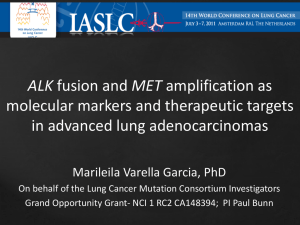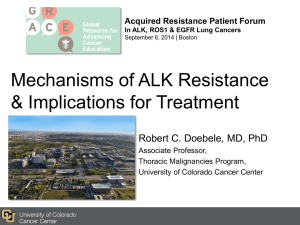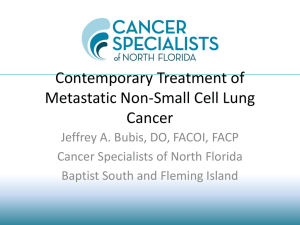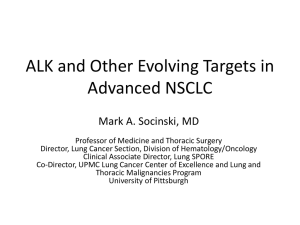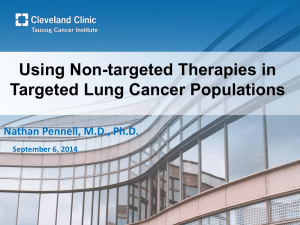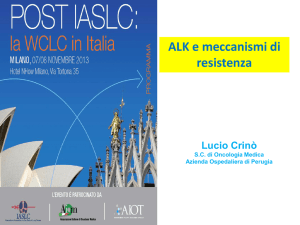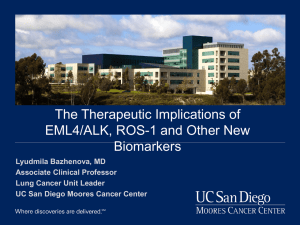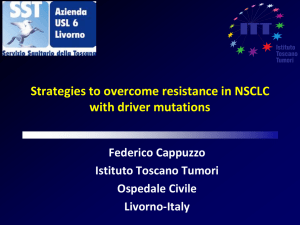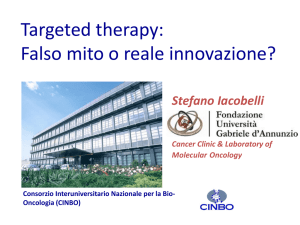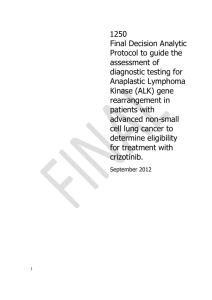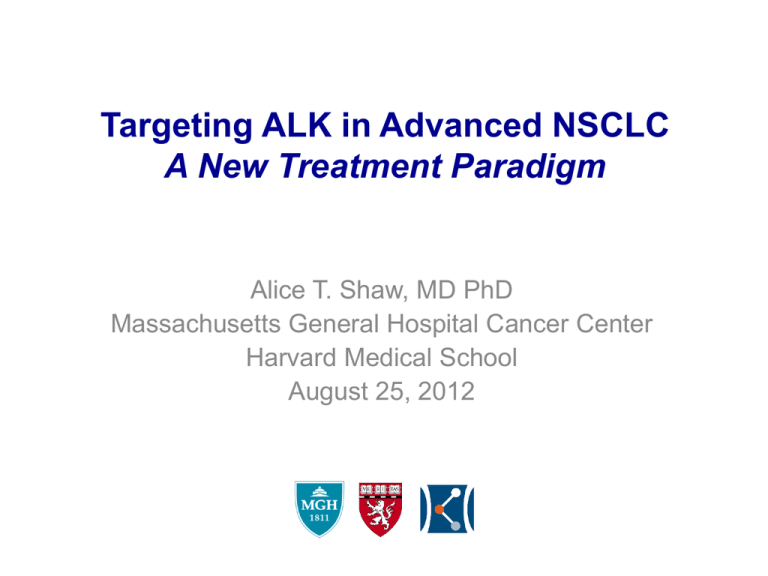
Targeting ALK in Advanced NSCLC
A New Treatment Paradigm
Alice T. Shaw, MD PhD
Massachusetts General Hospital Cancer Center
Harvard Medical School
August 25, 2012
Oncogenic Drivers in NSCLC
KRAS 24%1
EGFR 13%1
RET ~1%5
4
MET
~1%
1Sequist et al., Ann Oncol 22:2616, 2011
2Takeuchi et al., Nat Med, Feb 12 2012
NRAS 1%1
3Shaw et al., NEJM 365:158, 2011
4Kris et al., WCLC 2011
AKT ~1%3
5Takeuchi
et al., Nat Med, Feb 12 2012
PIK3CA 4%1
ALK 3%2
HER2 2%3
BRAF 2%1
ROS ~1%2
The Promise of Genotype-Directed Therapy
Treatment B
Treatment A
NSCLC
Treatment C
Treatment D
The Promise of Genotype-Directed Therapy
EGFR mutation
ALK (or ROS)
Erlotinib or gefitinib
Crizotinib, other ALK TKIs
NSCLC
Treatment C
Treatment D
NCCN Guidelines for the Management of
Stage IV NSCLC
Crizotinib
an update
Crizotinib: A Dual MET/ALK Tyrosine
Kinase Inhibitor
Kinase
IC50 (nM)
mean*
Selectivity
ratio
c-MET
8
–
ALK
40-60
5-8X
ROS
60
7X
RON
80
10X
294
34X
322
37X
Tie-2
448
52X
Trk A
580
67X
Trk B
399
46X
Abl
1,159
166X
IRK
2,887
334X
Lck
2,741
283X
Sky
>10,000
>1,000X
VEGFR2
>10,000
>1,000X
PDGFR
>10,000
>1,000X
Axl
Co-crystal structure of crizotinib (PF02341066) bound to c-MET
Cui et al. J. Med. Chem. 2011;54:6342-63 and Pfizer data on file
Marked Activity of Crizotinib in ALK+ NSCLC
Update of the Phase 1 Study
ORR = 60.8%* in 143 evaluable patients
(133 evaluable patients shown)
Median response duration = 49.1 wks
Median PFS = 9.7 mos
*Higher ORR in Asians vs non-Asians
-30
Camidge et al., Lancet Onc, in press
Phase 2 Study: PROFILE 1005
Key entry criteria
● Positive for ALK by central
laboratory (local testing
subsequently allowed on case-bycase basis)
● Progressive disease in Arm B of
PROFILE 1007 study
Crizotinib 250 mg BID
N=250
>1000
administered PO on a
continuous dosing
schedule
● >1 prior chemotherapy
● ECOG PS 0-3
● Stable/controlled brain mets
allowed
NCT00932451
Marked Activity of Crizotinib in ALK+ NSCLC
Update of the Phase 2 Study
Decrease or increase from baseline (%)
100
PD
SD
PR
CR
80
60
40
20
0
–20
–40
–60
–80
–100
+
+
++
–120
*n=240 response-evaluable patients from the mature population, and excludes patients with early death,
indeterminate response and non-measurable disease
+Per RECIST 1.1, percent change from baseline for subjects with best overall response of CR can be less than 100%
when lymph nodes are included as target lesions
Kim et al., ASCO 2012
Marked Activity of Crizotinib in ALK+ NSCLC
Update of the Phase 2 Study
Probability of survival without progression
1.0
Median PFS 8.1 months (95% CI: 6.8–9.7)
28% patients in follow-up for progression
0.8
+ Censored
95% Hall-Wellner Band
0.6
0.4
0.2
0
n at risk
0
5
261
175
10
Time (months)
95
15
20
26
2
Kim et al., ASCO 2012
PROFILE 1005: Any-Grade TreatmentRelated AEs in ≥10% of Patients
AE
Mature population, n=261
n (%)
Overall population, n=901
n (%)
Any AE
245 (93.9)
827 (91.8)
Vision disorder*
154 (59)
468 (51.9)
Nausea
148 (56.7)
423 (46.9)
Vomiting
116 (44.4)
352 (39.1)
Diarrhea
106 (40.6)
369 (41.0)
Constipation
86 (33.0)
249 (27.6)
Peripheral edema
72 (27.6)
211 (23.4)
Fatigue
64 (24.5)
163 (18.1)
Decreased appetite
59 (22.6)
167 (18.5)
Increased alanine aminotransferase
45 (17.2)
146 (16.2)
Dysguesia
43 (16.5)
149 (16.5)
Dizziness
40 (15.3)
95 (10.5)
Neutropenia
36 (13.8)
84 (9.3)
Increased aspartate aminotransferase
33 (12.6)
106 (11.8)
*Includes visual impairment, photopsia, vision blurred, vitreous floaters, photophobia and diplopia
Rare instances of fatal pneumonitis and fatal hepatotoxicity were reported in crizotinib clinical trial program
Phase 3 Study: PROFILE 1007
Crizotinib 250 mg BID
Key entry criteria
● Positive for ALK by
central FISH testing
● Stage IIIB/IV NSCLC
● 1 prior chemotherapy
(platinum-based)
● ECOG PS0-2
● Measurable disease
● Treated brain
metastases allowed1
R
A
N
D
O
M
I
Z
E
N=318
administered PO on
a continuous dosing
schedule
(N=159)
Endpoints
● Primary
- PFS (RECIST 1.1,
independent review)
● Secondary
- ORR, DR, DCR
Pemetrexed 500 mg/m2
or
Docetaxel 75 mg/m2
infused IV on day 1
of a 21-day cycle
- OS
- Safety
- Patient reported
outcomes (PROs)
(N=159)
NCT00932893
Next Generation ALK TKIs
LDK378
Mechanisms of Crizotinib Resistance
Target gene
alteration (28%)
??
No loss of ALK (26/26)
No EGFR or KRAS
mutations (21/21)
Bypass track
activation (45%)
*
*
ALK amplification
ALK mutation
EGFR activation
CKIT amplification
Unknown
LDK378: A Potent and Selective ALK Inhibitor
2,4-diaminopyrimidine derivative. MW: 558.14
Potent, ATP-competitive inhibitor of ALK
Assays
LDK378
IC50 (μM)
Crizotinib
IC50 (μM)
ALK (enzymatic)
MET (enzymatic)
0.00015
3.2
0.003
0.008
0.027
1.3
0.11
0.028
BaF3/ALK
BaF3/MET
Li et al., AACR-NCI-EORTC, 2011; Mehra et al., ASCO 2012
Preclinical Evaluation of LDK378 Activity
NCI-H2228 sensitive xenograft models
• LDK378 caused complete tumor regression after 14 days of treatment
• No growth of tumors for >4 months in mice treated with LDK378 50 mg/kg/day
Li et al., AACR-NCI-EORTC, 2011
Preclinical Evaluation of LDK378 Activity
Crizotinib-resistant xenograft models
ALK C1156Y mutation
No ALK mutation
• LDK378 at 50-100mg/kg/day has antitumor activity in different crizotinib-resistant models
Li et al., AACR-NCI-EORTC, 2011
Phase I study of LDK378
ALK+ lung cancer
Resistant to prior ALKi
Any ALK+ cancer
ALK+ lung cancer
Naive to prior ALKi
Non-lung ALK+ tumors
LDK378 continuous oral dosing
Primary objective: Determine the MTD
Secondary objectives: Safety, pharmacokinetics, and antitumor activity
NCT01283516
Baseline Patient Characteristics
Characteristic
Age (median), yrs (range)
All patients, n (%)
N=56
53 (22–78)
Sex (male)
19 (34)
ECOG Performance Status
0
1
2
10 (18)
39 (70)
7 (12)
Cancer type
NSCLC
Breast
Rectal
Alveolar rhabdomyosarcoma
50 (89)
4 (7)
1 (2)
1 (2)
Prior crizotinib
Crizotinib naive
37 (66)
19 (34)
Mehra et al., ASCO 2012
Adverse events associated with LDK378
• SAEs related to LDK378 have occurred in 5 patients
– Transaminase elevation (400 mg), vomiting (500 mg),
dehydration (600 mg), and interstitial lung disease (750 mg)
• All SAEs were reversible upon cessation of LDK378
– Two patients resumed treatment with LDK378 a lower dose
level
– Two had simultaneous progressive disease
• Common AEs included
– Nausea (59%), vomiting (54%), and diarrhea (48%), fatigue
(21%), and dyspnea (16%)
• Only one patient has discontinued treatment because of an AE
Mehra et al., ASCO 2012
Antitumor Activity of LDK378 in ALK+ NSCLC
NSCLC
Other diseases
Initial dose
(mg)
Patients (n)
Responses
<400
8
2 (25)
≥400
33
22 (67)
50–600
6
0
• Response rate 81% (21/26) in NSCLC patients treated at ≥400 mg
who progressed following crizotinib
– Responses include confirmed + unconfirmed per RECIST 1.0
(6 patients with PR awaiting confirmatory scans)
Mehra et al., ASCO 2012
Typical Responses to LDK378
Baseline
After 6 weeks on LDK378
Mehra et al., ASCO 2012
Typical Responses to LDK378
Baseline
After 6 weeks on LDK378
Mehra et al., ASCO 2012
CNS Activity of LDK378
Baseline
After 6 weeks on LDK378
Mehra et al., ASCO 2012
Summary of LDK378
• The MTD of LDK378 is 750 mg PO qd
• The most common AEs are nausea, vomiting and
diarrhea
• LDK378 exhibits potent antitumor activity in
patients with ALK+ NSCLC, particularly in those
who have progressed following crizotinib
• LDK378 is active in brain metastases
Other Next Generation ALK TKIs
CH5424802
AP26113
CH5424802 is a Potent and Selective ALK TKI
A
C
B
Sakamoto et al., Cancer Cell 2011;19:679-90
AP26113 is a Potent and Selective ALK TKI
Relative Cell Viability
Crizotinib
100
AP26113
EML4-ALK
-L1196M
75
50
75
50
EML4-ALK
25
0
ALK-negative
cells
100
1
10
100
25
1000
10000
0
1
10
100
1000
10000
Drug Concentration (nM)
>
>
>
Ba/F3 cells (ALK-negative) engineered to express EML4-ALK or the L1196M mutant
AP26113, but not crizotinib, inhibits viability of the L1196M mutant with high
selectivity
Similar results obtained with multiple other mutants, including G1269S, S1206R,
C1156Y, F1174C, F1245C, I1174T and L1152V
Zhang et al, AACR 2010
Phase I/ II Schema
Phase 1/2 Study of AP26113
Cohort 1: N=20
NSCLC: ALK rearrangement and
ALK inhibitor naïve
Dose Escalation Cohorts
N=30 to 50
Advanced malignancies
All histologies except leukemia
ECOG 0-2
CNS mets allowed if stable for 8
wks
Oral AP26113, 30 mg once daily
(QD) starting dose
→
Dose level cohorts escalating until
RP2D is established
* Tissue must be obtained after
development of resistance to ALK (cohort 2)
or EGFR (cohort 3) TKI therapy
* Cohort 2: N=20
NSCLC: ALK rearrangement and
resistant to at least 1 prior ALK inhibitor
* Cohort 3: N=20
NSCLC: EGFR activating mutation and
resistant to at least 1 prior EGFR inhibitor
Cohort 4: N=20
Other cancers with abnormal targets
eg, ALK, ROS, and others
Summary
• Crizotinib is now a standard therapy for patients
with advanced, ALK+ NSCLC
- ORR 60%
- Median PFS 8-9 months
- Phase 3 studies
• More potent ALK TKIs like LDK378 may be effective
salvage therapies for the majority of patients who
relapse on crizotinib
Future Directions
•
Timing of next generation ALK TKIs
- Front-line use of next generation ALK TKIs
•
Mechanism of action
- Overcoming resistance vs more potent target
inhibition
•
Resistance to next generation ALK TKIs
•
Developing combination strategies

